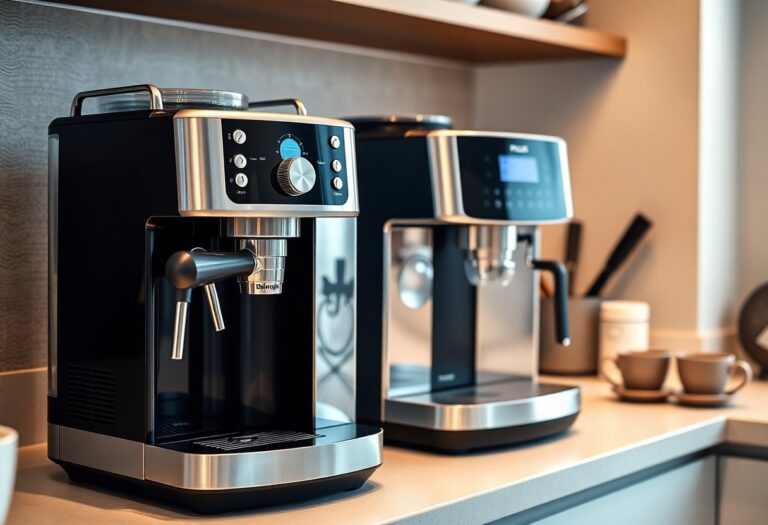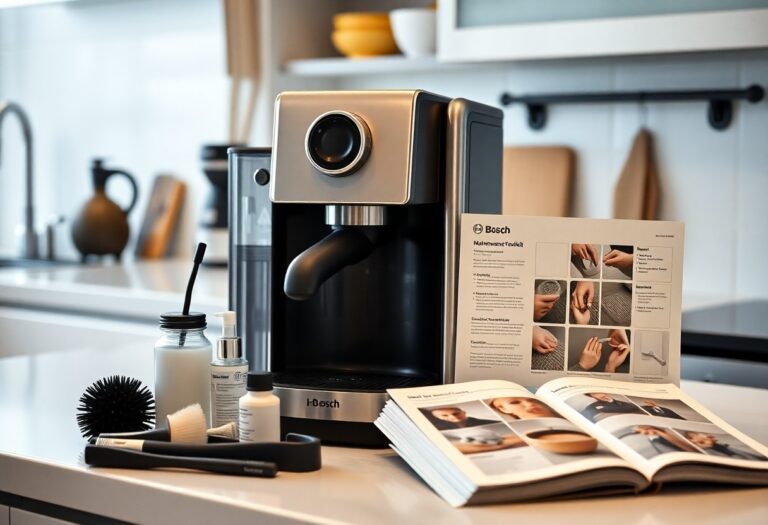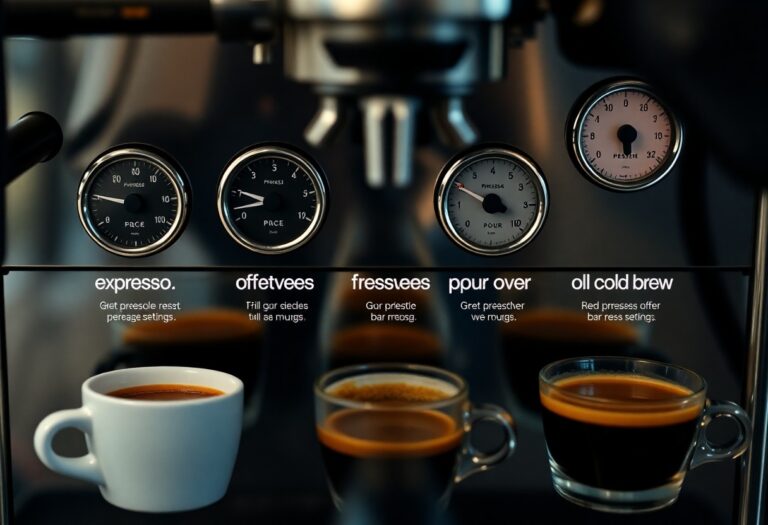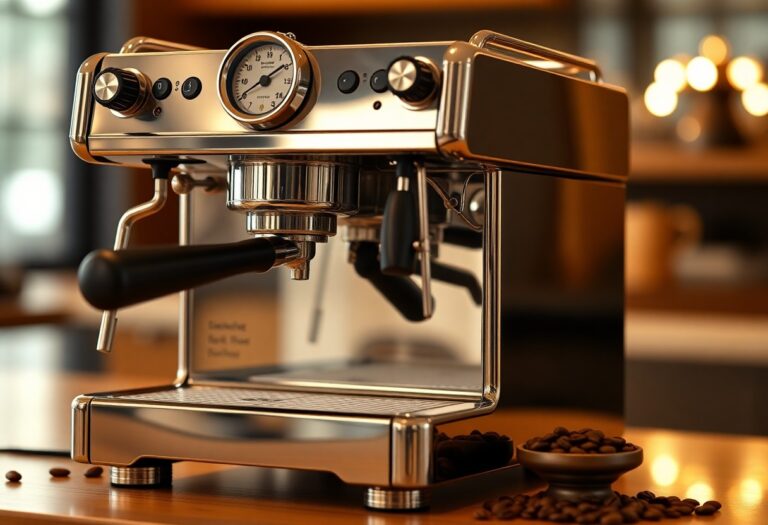What Coffee Machine is Best for Iced Coffee – Cold Brewing
With so many options available, selecting the right coffee machine for iced coffee can be overwhelming. You want a system that not only delivers exceptional flavor but also simplifies your brewing process. Whether you’re a beginner or an experienced coffee enthusiast, knowing which machines excel at cold brewing makes all the difference. To help you choose wisely, we’ve compiled information from The 11 Best Cold-Brew Coffee Makers You Can Buy, ensuring you make an informed decision for your iced coffee cravings.
Key Takeaways:
- Consider a coffee machine with specialized features for cold brewing, such as a dedicated cold brew function or a slow drip system, to enhance flavor extraction.
- Look for machines that allow for adjustable brew strength to cater to personal taste preferences, ensuring the right balance for iced coffee.
- Evaluate the capacity of the coffee maker; larger models can produce more cold brew at once, making them ideal for serving multiple cups or for batch brewing.
- Choose a model that offers ease of cleaning, as cold brew methods can leave behind residues that require thorough maintenance.
- Always check for user-friendly options, such as programmable settings and ease of use, to ensure a smooth brewing experience.

Choosing the Right Coffee Machine for Cold Brewing
Selecting the optimal coffee machine for cold brewing can dramatically enhance your iced coffee experience. Several factors, including functionality, ease of use, and brewing time, play a vital role in your decision-making process. By focusing on what features matter most to you, you can narrow down your options and find the most fitting machine to craft your perfect cold brew at home.
Key Features to Look For
When looking for the right coffee machine, consider these crucial features to ensure a satisfying cold brewing experience:
- Brew Capacity: Consider how much coffee you want to create at once.
- Brewing Time: Some machines allow quicker extraction, while others take longer for optimal flavor.
- Material: Glass or plastic can influence durability and flavor retention.
- Filter System: A good filter will help keep grit out of your cold brew.
- Ease of Cleaning: Machines that disassemble easily save time.
Assume that you prioritize these features, which will lead you to the most suitable cold brew coffee machine for your needs.
Comparing Manual vs. Automatic Cold Brew Systems
The choice between manual and automatic cold brew coffee systems largely depends on your preferences for convenience and control over the brewing process. While manual systems afford you meticulous oversight of the brewing time and water-to-coffee ratios, automatic systems simplify the process with pre-set functions.
| Aspect | Manual Cold Brew |
|---|---|
| Control | High control over brewing process and adjustments. |
| Convenience | Requires more active involvement and time. |
| Flavor Customization | Experiment with different coffee grounds and steeping times. |
| Price | Typically lower initial cost. |
| Aspect | Automatic Cold Brew |
|---|---|
| Control | Limited control, reliant on machine settings. |
| Convenience | Quick and easy with minimal effort required. |
| Flavor Customization | Less room for variability; consistent results. |
| Price | Generally higher initial investment. |
Delving deeper into the comparison reveals that manual systems may yield superior flavor profiles while allowing for greater experimentation. But if speed and convenience are paramount to you, an automatic cold brew machine may just be the ticket to effortlessly enjoying your cold coffee creations. Evaluate your lifestyle and taste preferences to find the best fit that aligns with your daily routines and cold brew aspirations.

The Top Contenders in Cold Brew Coffee Machines
You’ll find a myriad of options when exploring cold brew coffee machines. Some standout models include the GROSCHE Madrid Cold Brew Maker, renowned for its stylish design and ease of use, and the Takeya Patented Cold Brew Coffee Maker, which delivers a concentrated brew with minimal hassle. For those seeking luxury, the Café Specialty Drip Coffee Maker provides customizable features while maintaining a sleek, modern aesthetic. Each of these machines offers unique benefits tailored to different preferences, ensuring a satisfying cold brew experience.
Analyzing Popular Brands and Their Features
Leading brands frequently cater to various preferences and budgets, showcasing an array of features that appeal to avid cold brew enthusiasts. For example, Primula emphasizes affordability and user-friendliness, while Bodum focuses on craftsmanship and aesthetics. KitchenAid offers premium, multifunctional machines, catering to connoisseurs who want versatility in addition to cold brew capability. With these options, determining the right fit depends on your coffee lifestyle and brewing habits.
Price vs. Performance: Finding the Sweet Spot
Budget considerations are necessary when selecting a cold brew coffee machine, as prices range from under $20 to over $200. Balancing performance with cost involves assessing features crucial to your brewing needs. However, investing in a moderately priced machine, around $50 to $100, often provides exceptional quality without breaking the bank. Research and reviews can further illuminate if the higher-priced models justify their cost.
Striking the right balance between price and performance involves evaluating the features that matter most to you. A thoughtfully designed cold brew maker, like the Takeya Cold Brew Coffee Maker, emphasizes durability and efficiency, delivering great-tasting coffee at a reasonable price. Alternatively, if you prioritize advanced features, machines like the
Crafting the Perfect Iced Coffee: Techniques and Tips
To achieve the ultimate iced coffee experience, focus on the right brewing methods and presentation. Use fresh, high-quality coffee beans for a robust flavor. Pay attention to water temperature and brewing time; a longer steep yields a smoother taste. Ice should be made from coffee itself to avoid dilution. Consider adding a splash of milk or flavored syrups to customize your drink. Experimenting with different brewing techniques can enhance your iced coffee. Any of these approaches can elevate your home brew to café-quality excellence.
Mastering the Cold Brewing Process
The cold brewing process requires patience but yields a wonderfully smooth coffee concentrate. Start with a coarse grind of coffee, using a gear ratio of 1:4 with cold water. Steep the mixture for 12 to 24 hours in the refrigerator, then strain through a fine mesh filter or coffee cloth. This method extracts oils and sugars without the bitterness associated with traditional hot brewing, creating a naturally sweet flavor profile that’s perfect for iced coffee lovers.
Enhancing Flavor Profiles with Innovations
Discovering new ways to enhance the flavor of your iced coffee opens up a world of possibilities. Incorporating elements like vanilla beans, cardamom, or even a hint of mocha can transform classic brews into unique concoctions. You might enjoy trying flavored syrups or even infusing your coffee grounds with spices before brewing. Experiment with different milk alternatives, such as oat or almond milk, to add depth and richness to your drink. Ice cubes made from coconut milk or fruit juice also contribute delightful twists to each sip.
Mixing flavors isn’t just about adding sweetness; it’s an art of balancing contrasting tastes. Adding a dash of sea salt can sometimes amplify flavors, while spices like cinnamon can introduce warmth. For a refreshing burst, you could muddle mint leaves or infuse cold brew with herbs. Incorporating innovative ingredients and techniques can not only personalize your iced coffee but also bring out latent qualities in the base coffee you select, enriching the entire drinking experience.
The Environmental Impact of Your Coffee Choices
Your coffee choices extend beyond taste; they also impact the environment. For every cup of coffee, consider factors like packaging waste and water consumption. Opting for eco-friendly equipment can reduce your carbon footprint. Explore Iced Coffee Makers designed with sustainability in mind will help in making conscientious choices while enjoying your favorite beverage.
Eco-Friendly Machines: What to Consider
When identifying a coffee machine for iced coffee, you should prioritize energy-efficient models that reduce electricity consumption. Look for machines that use recyclable components or are built to last, lessening the need for replacements over time. Additionally, some brands incorporate sustainable materials in their production processes, offering a greener alternative without compromising quality and functionality.
Sustainable Practices in Cold Brewing
Cold brewing can be more eco-friendly than traditional brewing methods. By using coarsely ground coffee and cold water, you can extract flavors over an extended period, which can also result in less energy consumption. Moreover, a larger batch can be made at once, minimizing the need for multiple brew cycles and reducing your overall resource usage.
Utilizing sustainable practices in cold brewing can significantly enhance your environmental impact. For instance, brewing in larger quantities not only saves energy but also reduces the amount of coffee grounds generated. Choosing beans from farms that practice regenerative agriculture ensures that the coffee you enjoy supports biodiversity and minimizes environmental harm. Customary composting of used coffee grounds contributes to local soil health, making your cold brew ritual a part of a sustainable lifestyle. Seeking out local roasters that prioritize packaging waste reduction further enhances your commitment to environmental consciousness.
Expert Insights: What Baristas Say About Cold Brew Machines
When seeking insight from baristas, you’ll find a consensus around the significance of brewing time and water temperature in producing a quality cold brew. Many professionals emphasize that the best machines allow for precise control over these elements, enabling you to experiment with different coffee grounds and water ratios for optimal flavor extraction. According to experts, good equipment maintains a consistent steeping process, ensuring that no bitterness creeps in—an necessary factor for making truly exceptional iced coffee.
Interviews with Specialty Coffee Professionals
Conversations with specialty coffee professionals reveal that many prefer manual methods over automatic machines for cold brewing. They argue that the connection to each step—grinding, steeping, and filtering—plays a pivotal role in achieving a nuanced flavor profile. The tactile nature of these processes allows for greater experimentation and understanding of the beans, enriching your cold brew experience.
Recommendations Based on Experience
Baristas often recommend selecting cold brew systems that feature adjustable steeping times and brewing sizes. For example, machines that allow for a steeping time of 12 to 24 hours provide flexibility to experiment with flavors. Devices like the Toddy Cold Brew System or Yama Glass Cold Brew Tower are praised for their ability to produce smooth, rich flavors while minimizing acidity. Your choice ultimately depends on how involved you want to be in the brewing process, as well as the quantity of cold brew you wish to produce.
To wrap up
Considering all points, selecting the best coffee machine for iced coffee and cold brewing hinges on your specific preferences and lifestyle. Whether you opt for a dedicated cold brew maker, a versatile pour-over setup, or a high-quality French press, each option presents unique advantages that cater to different brewing needs. Evaluate your desired flavor profile, convenience, and brewing time to ensure you choose a machine that will enhance your iced coffee experience. With the right equipment, you can easily enjoy refreshing cups of cold brew that suit your taste perfectly.
FAQ
Q: What type of coffee machine is best for making iced coffee using the cold brew method?
A: For cold brewing, a dedicated cold brew coffee maker is ideal. These machines typically have a large filter that allows coarse coffee grounds to steep in cold water for an extended period, usually 12-24 hours. Popular options include the Takeya Cold Brew Maker and the Filtron Cold Brew System, which are designed specifically for maximized flavor extraction during the cold brewing process.
Q: Can I use a standard drip coffee maker for cold brewing iced coffee?
A: It’s not advisable to use a standard drip coffee maker for cold brew since they usually require hot water to brew coffee. While some drip coffee makers offer an iced coffee option, these typically brew hot coffee that is then chilled, rather than adhering to the traditional cold brew method, which involves steeping grounds in cold water. For the authentic cold brew experience, opt for a dedicated cold brew machine.
Q: How does the brewing time affect the flavor of cold brew coffee?
A: The brewing time is a significant factor in developing the flavor profile of cold brew coffee. Typically, steeping coffee grounds for 12-24 hours in cold water results in a smoother, less acidic taste compared to quicker methods. If you prefer a bolder flavor, you can experiment with longer steeping times, but remember that over-extraction might lead to bitterness. Adjusting the coffee-to-water ratio is also a way to influence flavor without changing steeping time.
Q: Is it possible to make iced coffee using a French press?
A: Yes, you can use a French press to make cold brew iced coffee. To do this, simply add coarsely ground coffee and cold water to the press, stir gently, and let it steep for 12-24 hours. Once ready, press the plunger down and pour the brewed coffee over ice. This method yields a rich, flavorful cold brew, utilizing the French press’s built-in filtration system.
Q: What features should I look for in a cold brew coffee maker?
A: When choosing a cold brew coffee maker, consider features such as the size (how much coffee it can produce), ease of use (simple assembly and cleaning), filtration system (fine mesh or paper filters), and any additional functionalities like a built-in tap or handle for easy pouring. Additionally, look for materials that are durable and BPA-free for safe beverage preparation. Brands like OXO and Takeya offer excellent options that combine convenience and quality.







